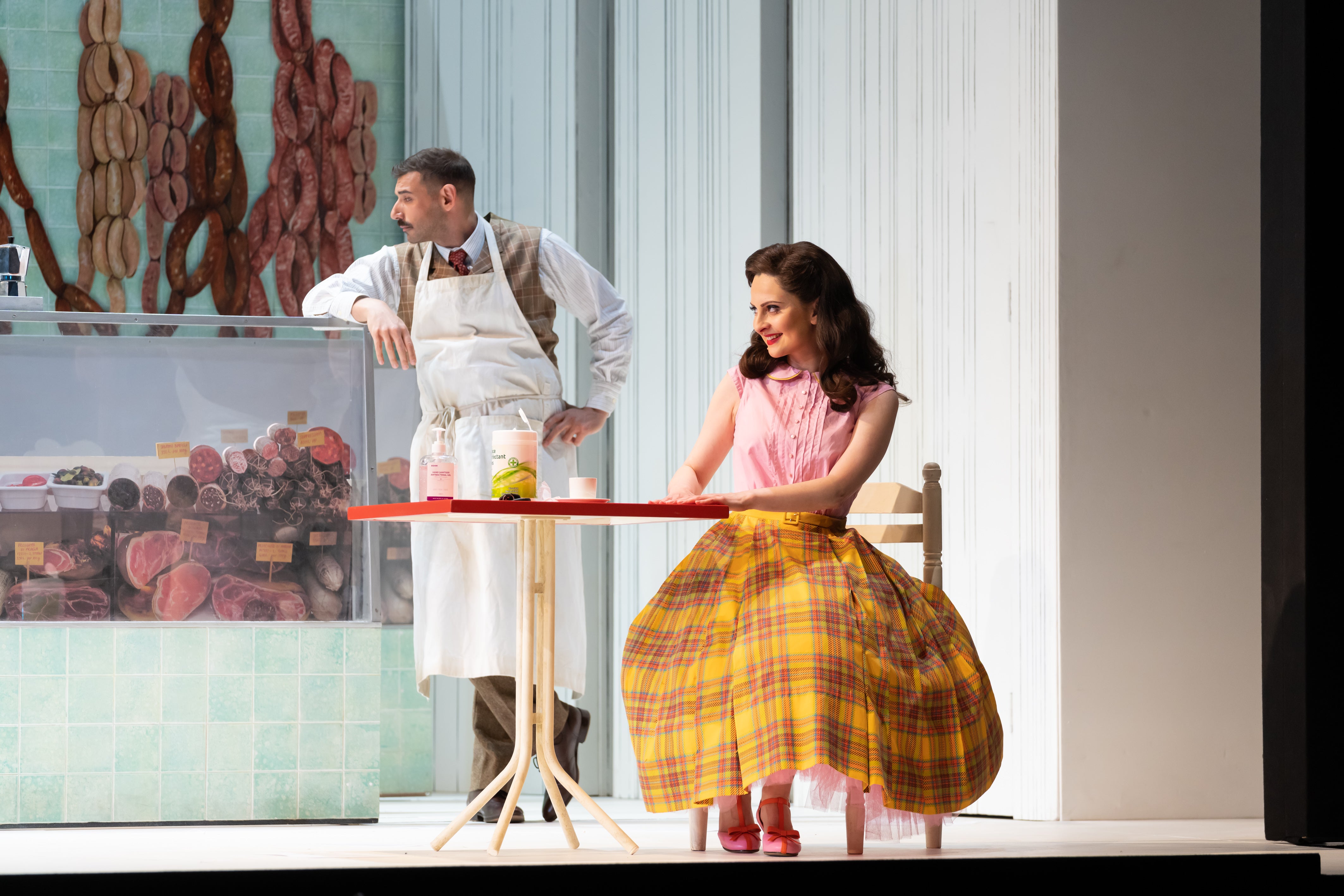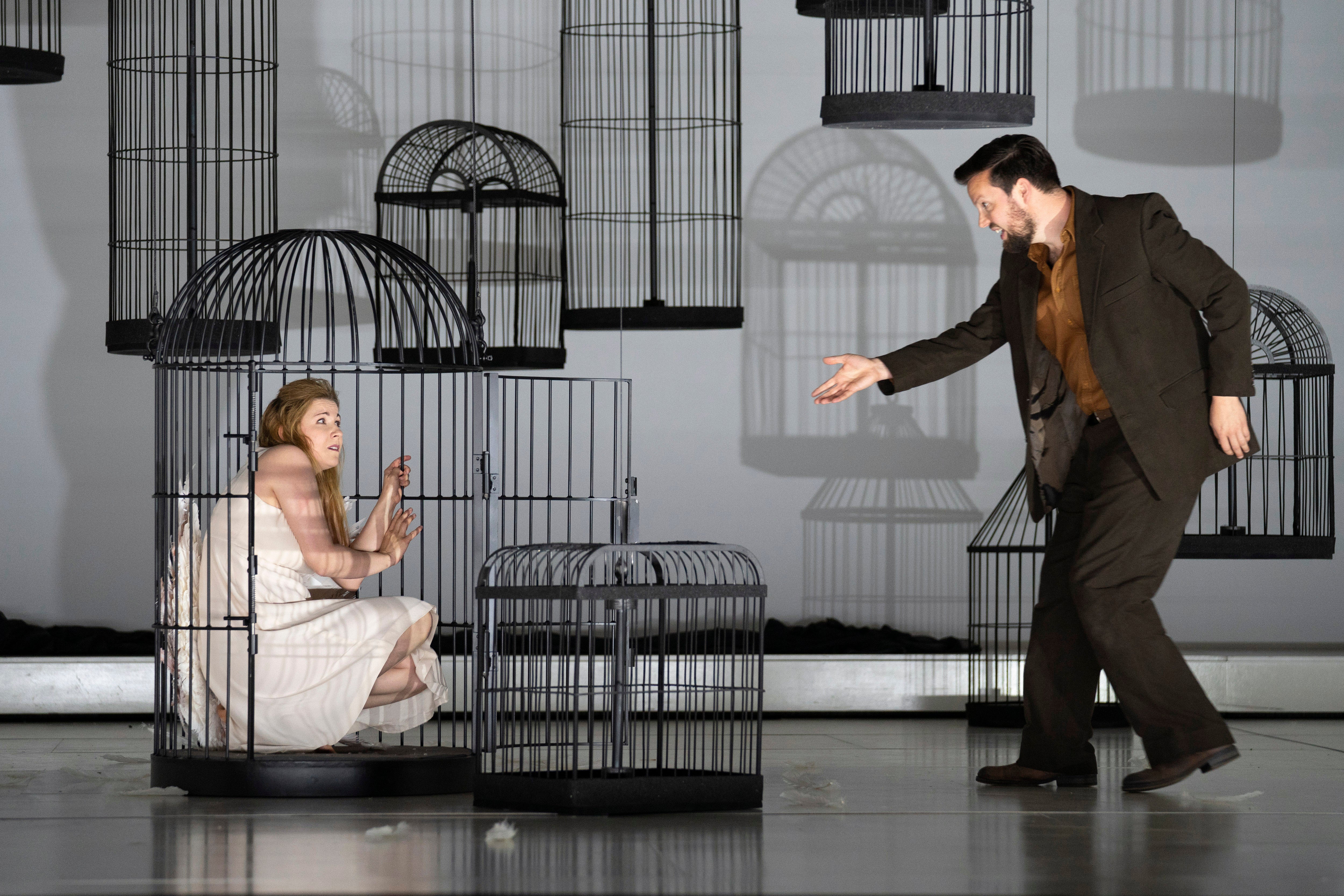The return of Glyndebourne: It’s a blessed relief to sit in the stalls after lockdown
Neither rotten weather nor the need to accommodate the pandemic by playing masked to half-empty houses can dampen the excitement of its reopening for business, says Michael Church

One by one, Britain’s country house opera companies are preparing for rebirth after a year of hibernation – and it’s no surprise that Glyndebourne should be first out of the traps. This East Sussex idyll was the original exemplar for the genre and it’s spawned many imitations, but none so magical. Neither rotten weather nor the need to accommodate the pandemic by playing masked to half-empty houses can dampen the excitement of its reopening for business.
The first offering is a new production of Janacek’s Kat’a Kabanova directed by Damiano Michieletto, and although it has faults, it provides powerfully moving entertainment. Kat’a is married to Tichon, a booby whose mother Kabanicha hates her. Despite her horror at adultery, Kat’a loves Boris, and agrees to meet him in her garden; stress leads to a breakdown during which she publicly confesses her guilt, and finally, she throws herself into the Volga.
Taking his cue from the libretto – Kat’a wonders why we all can’t spread our wings and fly like birds – Michieletto pursues this idea throughout the drama, beginning with a single white feather drifting down from the heavens that Kat’a clutches at desperately. Then a male winged dancer appears, and a birdcage, and gradually the stage fills with such creatures, while the one birdcage multiplies to a thicket of birdcages. The whole thing becomes an elaborate piece of choreography.
The downside of this is that the real drama gets periodically upstaged – notably when a duet between Kat’a and Boris should be counterpointed by a parallel duet between Kat’a’s friend Varvara and her lover Kudrjas. The tremulousness of one needs to contrasted with the carefree quality of the other – it should be the high point of the evening – but here that contrast is systematically smudged.
But the shimmering beauty of the score – conducted by Robin Ticciati with loving attention to every small ebb and flow of expressiveness – and the performances of the cast, with no weak link, transcend the faults of the direction. Tenor Thomas Atkins and Aigul Akhmetshina vibrantly incarnate the carefree lovers, while Katarina Dalayman’s Kabanicha exudes ironclad menace, and Nicky Spence movingly communicates the desperate impotence of Tichon. With David Butt Philip’s Boris as her foil, Katerina Knezikova makes an unforgettable Kat’a, covering a gamut of emotions from naïve bewilderment and hallucinatory wonder to fatalistic despair; underscored by sighs and cries from strings and woodwind, her final scenes have the momentum of a dream.
Glyndebourne’s second show could not be more different: a version of Rossini’s Il turco in Italia, directed by Mariame Clément, that is so fizzingly original that it might be an entirely new work. The basic plot is simple – a horny young wife swaps her clumsily doting husband for a swashbuckling Turk – with the action framed as a work-in-progress by a dramatist suffering from writer’s block. But the twists Rossini builds into it, and the additional comic layers that Clément adds with plate-spinning assurance, make the brain reel.
At any given moment, we get four parallel stories: the writer’s desperate commentary, his scribbled drafts back-projected behind him, the singers’ libretto, and the changes they themselves suggest for it. And although there’s just one basic set, the witty transformations to which designer Julia Hansen subjects it, make it seem like a kaleidoscope of worlds.
Physical and sung comedy here go hand in hand, thanks to a young cast of brilliant singer-actors, even actor-dancers in the case of Rodion Pogossov’s cuckolded Don Geronio, who at one point flawlessly pirouettes around the stage. Tenor Michele Angelini sings his most ravishing bel canto aria while garlanding himself with a string of sausages in the Neapolitan delicatessen that is the locale for Act Two. In the central role as Donna Fiorilla, soprano Elena Tsallagova effortlessly commands the stage, with a non-stop display of gorgeous singing and irresistibly comic acting. Conductor Sestro Quatrini and the London Philharmonic keep things bubbling every step of the way. After 15 months of CDs and streamed performances, it’s a blessed relief to sit in the stalls and luxuriate in the real live thing after lockdown.
Glyndebourne was set up in 1934 by John Christie, whose family owned the surrounding estate with its 17th-century manor house, and its initial ethos reflected the eccentricities of its owner. Christie’s childhood was a parody of upper-class awfulness: while his deranged father beat his over-protective mother Lady Rosamond Wallop, he himself got walloped at Eton, was crippled in a riding accident, and lost the sight in one eye while playing rackets.
Thus was forged the iron will that gave birth to Glyndebourne and defined its exclusivity. He once declared that he would, if he could, “have surrounded Glyndebourne with barbed wire to keep out the unworthy”. He was a passionate Germanophile, wearing lederhosen and labelling his lavatories “Damen” and “Herren”. He was also a homophobe, thanks to which Glyndebourne and Benjamin Britten, who should have been a match made in heaven, never hit it off.

Hitler’s emergence both neutralised Christie’s Germanophilia and set the opera company on the path from which it has never deviated, as top musicians from Germany escaped to Glyndebourne. Mozart was their first calling card. The excellence of their productions derived from the exceptionally long rehearsal periods that still guarantee Glyndebourne’s excellence today. At Covent Garden, the big stars have traditionally jetted quickly in and out, but at Glyndebourne they’re expected to be on-site for half the summer.
Eighty years on, now run by Christie’s grandson Gus Christie, Glyndebourne maintains artistic standards as high as anywhere. Apart from a grant to support its education work, it gets no public subsidy, and its devoted regulars helped financially to see it through the dark period of lockdown last year.
Now the Glyndebourne experience is back. Evening dress is not obligatory, but almost all men wear it. Seat prices start at £40 but rise to £260; the core audience is a mixture of old money, new money, and those with an expense account. Once in the gardens, there is a decorous dash for the best spots to picnic in fine weather by the lily pond. Mock it if you like, but the ritual has old-world charm.



Join our commenting forum
Join thought-provoking conversations, follow other Independent readers and see their replies
Comments